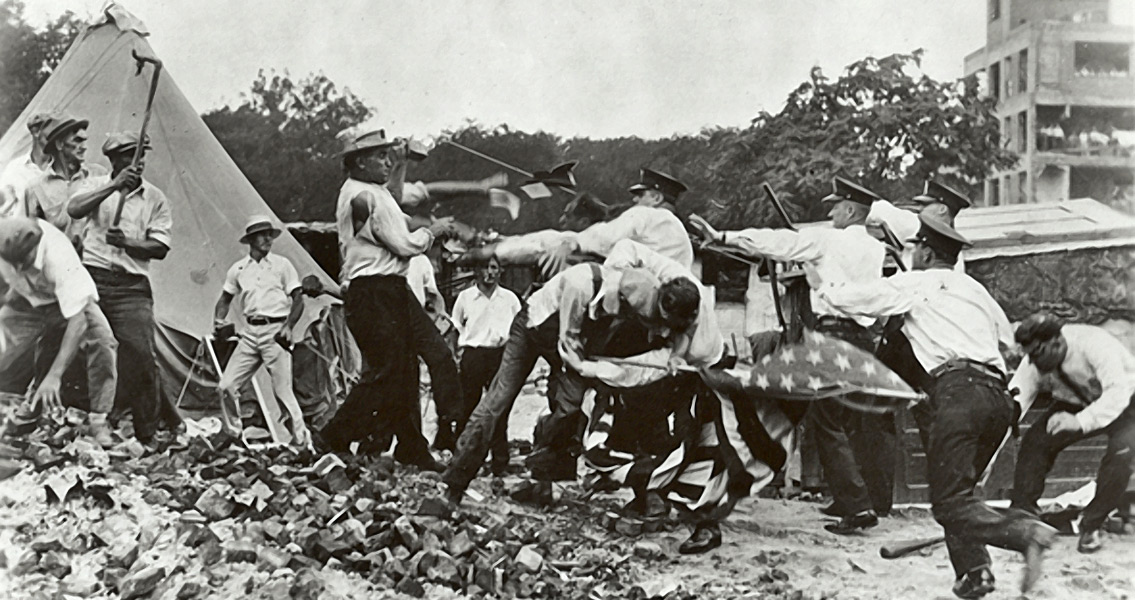<![CDATA[On 28th July, 1932, the US Army forcibly evicted Bonus Marchers from the protest camp they had set up in Washington D.C. Coming in the middle of the Great Depression, the event was taken as further evidence that President Herbert Hoover had no sympathy for the plight of the poorest in American society. The Bonus Marchers were veterans of the First World War who had first marched on Washington in May 1932 seeking cash payment of their veterans' bonuses. In 1918, following the end of the war, the US Government assumed that its war risk insurance plan would adequately provide for sailors and soldiers who had served in the conflict. Over the next few years however, veteran protests made it clear that this compensation was inadequate to support the former soldiers and their families. In 1924, the US Congress voted to allot $3,500,000,000 in funds to the veterans of the First World War. The new scheme was adjusted to reflect the length of service, and provided extra payment to those who had served overseas. Under the new system, a soldier who had served abroad would receive $1.25 for each day of service, or a maximum of $625. Inevitably, the treasury could not afford to pay the vast sum required immediately, and so instead issued each soldier with a bond which would be payed over a twenty year period until 1945. Adjusted to interest, the bonds meant that many veterans were owed $1000 by the US government. The onset of the Great Depression in 1929 put enormous strain on American families, leading to mass unemployment, shortages of food, and homelessness. 1932 was the lowest point of the economic catastrophe: frustration mounted as laissez-faire politics seemed incapable of delivering a solution, and bread shortages spread throughout the country. Shanty towns started to spring up around formerly affluent areas, and protesters marched on Washington with increasing frequency. A riot at Ford's River Rouge plant in Michigan left four people dead and over fifty wounded. It was in this volatile context that a group of some 1,000 unemployed veterans decided to march on Washington to demand cash payment of their war bonuses, in support of the Veteran's Bonus Bill introduced by Texas senator John Patman. Other veterans groups soon joined in the protest and headed to Washington, swelling the number of protesters to around 20,000. The veterans camped out at Anacostia Flats, a former army recruitment centre, building temporary homes and declaring that they would not leave until the bill was passed. On 12th June the Veteran's Bonus Bill passed through the House of Representatives. Two days later however, it was defeated in the Senate. The protestors were ordered to leave the capital, but refused to do so. Failed attempts by the police to move the soldiers saw the US army called in to evict them forcibly. Troops, led by General Douglas MacArthur, advanced on the veterans' camps with swords drawn and four tanks in support. Even when the protesters attempted to flee across the Anacostia River the troops continued their pursuit, and started to torch the camps. McArthur justified the ruthlessness of his orders by claiming that the Untied States was on the verge of a Communist Revolution. The image of US soldiers attacking veterans however, was a potent one which caused outrage around the USA. Hoover continued to defend the repression with claims that anarchists, radicals and communists had infiltrated and dominated the mob. This defence gradually unraveled however, as evidence started to emerge that 90% of the protesters had indeed been veterans, and up to 20% were disabled. Whatever the reasons for the excessive force leveled at the Bonus Marchers, it seriously damaged Hoover's already failing public image, leading to his electoral defeat to Franklin D. Roosevelt. Some four years later the Veteran's Bonus Bill eventually passed through Congress, giving the veterans their payment some seventeen years after the war had finished. ]]>
US Army Evicts Bonus Marchers
